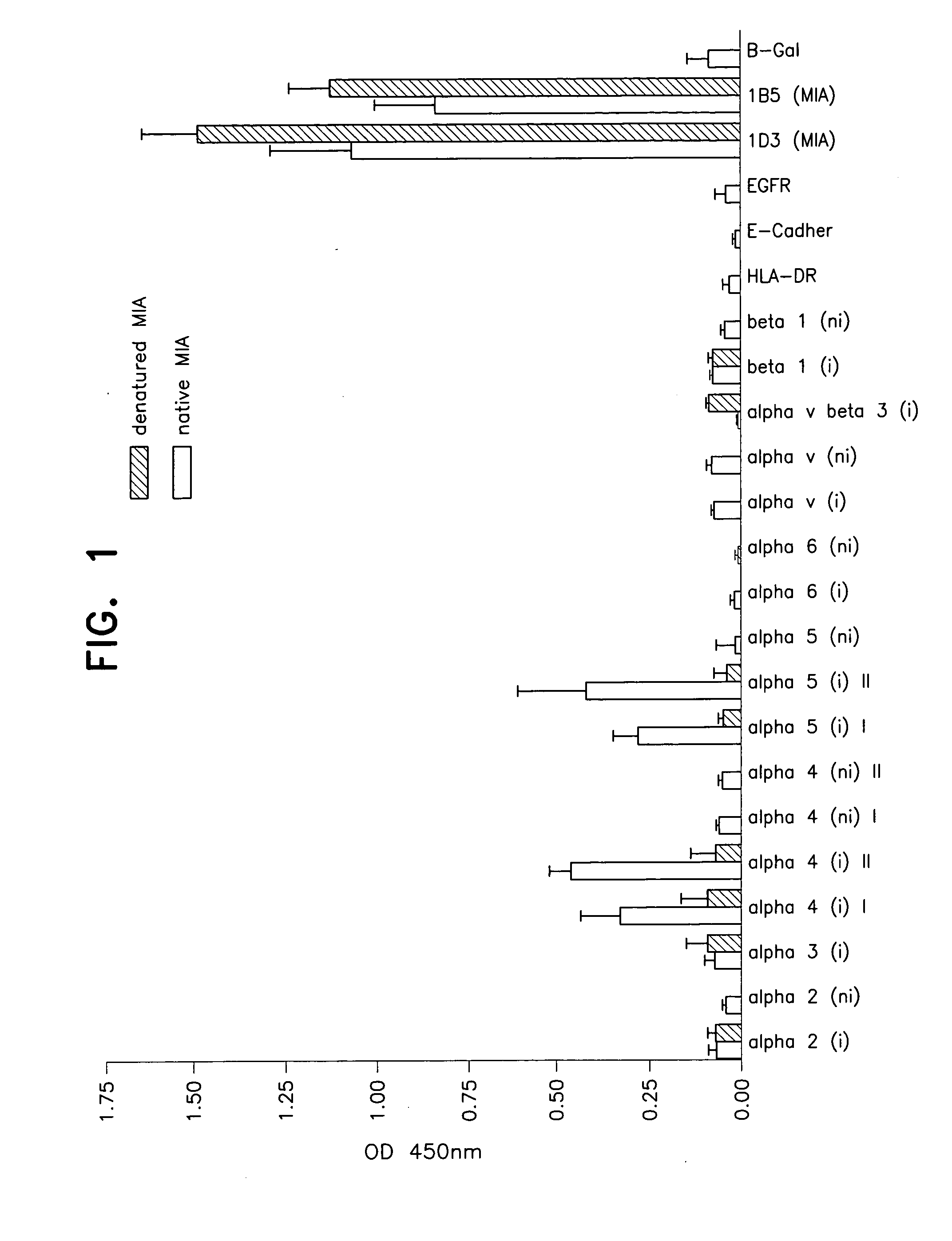Method for inhibiting "Melanoma Inhibitory Activity" MIA
- Summary
- Abstract
- Description
- Claims
- Application Information
AI Technical Summary
Benefits of technology
Problems solved by technology
Method used
Image
Examples
example 1
[0044]Phage display screening was performed using heptapeptide and do-decapeptide phage display libraries (BioLabs, Beverly, Calif. USA) following the manufacturer's instructions. Recombinant human MIA was coated onto the wells of a high protein-binding 96-well plate at a concentration of 10 micrograms per well. Binding phages were selected by incubation in the MIA-coated plates for 60 min at room temperature. For each selection, 2×1011 phages were added per well. Non-binding phages were removed by washing five times with TBS (Tris-buffered saline) for 10 min; bound phages were eluted by adding rhMIA (recombinant human MIA) at a concentration of 100 micrograms / ml. The eluted phages were amplified and the biopanning was repeated four times. The binding clones were characterized by sequencing the phage insert.
Result
[0045]Results of the phage display screening revealed a high percentage of clones carrying heptapeptides with multiple prolines. Out of 40 isolated and sequenc...
example 2
MIA Immunoassay
[0046]MIA was coated to 96-well plates and incubated for 30 minutes with 1 microgram / ml of the following monoclonal antibodies: Anti-alpha2-integrin (P1E6, DAKO, Hamburg, Germany), anti-alpha2-integrin (A2-11E10, UBI, Lake Placid, N.Y., USA), anti-alpha3-integrin (P1B5, DAKO, Hamburg, Germany), anti-alpha4-integrin (A4-PUJ1, UBI, Lake Placid, N.Y., USA), anti-alpha4-integrin (B-5G10, UBI, Lake Placid, N.Y., USA), anti-alpha4-integrin (P4C2, Chemicon), anti-alpha4-integrin (P1H4, Chemicon), anti-alpha4-integrin (AB1924, Chemicon), anti-alpha5-integrin (A5-PUJ5, UBI, Lake Placid, N.Y., USA), anti-alpha5-integrin (P1D6, Chemicon), anti-alpha5-integrin (AB1949, Chemicon), anti-alpha6-integrin (A6-ELE, UBI, Lake Placid, N.Y., USA), anti-alpha6-integrin (provided by Dr. E. Klein, Würzburg), anti-alpha-v-integrin (P3G8, Chemicon), anti-alpha-v-integrin (AB1930, Chemicon), anti-alpha-v-beta 3-integrin (Lv 230), anti-alpha-v beta 3-integrin (LM609, Chemicon), anti-beta1-integr...
example 3
[0049]To measure the effect of SEQ ID NO: 16 and SEQ ID NO:22 on the metastatic potential of B16 melanoma cells in vivo an experimental metastasis assay was used (Bosserhoff et al., 2001, Melanoma Res. 11, 417-421). Intravenous injections of monodispersed tumor cells (1×105 cells per animal) were performed into syngeneic C57BI6 mice (n=12 for every peptide as well as control). Peptides (550 μg / mouse) or PBS was injected every day. After 18 days the mice were sacrificed, the lungs removed, washed in PBS, fixed in formalin and the visible tumor nodules on the surface of the lungs were counted and the tumor areas measured.
Results
[0050]Both in vitro and in vivo MIA expression levels strictly correlate with an highly invasive phenotype (Bosserhoff et al., 1996, J. Biol. Chem. 271, 490-495; Bosserhoff et al., 1999, J. of Pathology 187, 446-454). Further in vivo studies have shown the necessity of MIA for melanoma invasion and metastasis (Bosserhoff et al., 2001, Me...
PUM
| Property | Measurement | Unit |
|---|---|---|
| concentration | aaaaa | aaaaa |
| 3D structure | aaaaa | aaaaa |
| multidimensional NMR spectroscopy | aaaaa | aaaaa |
Abstract
Description
Claims
Application Information
 Login to View More
Login to View More - R&D
- Intellectual Property
- Life Sciences
- Materials
- Tech Scout
- Unparalleled Data Quality
- Higher Quality Content
- 60% Fewer Hallucinations
Browse by: Latest US Patents, China's latest patents, Technical Efficacy Thesaurus, Application Domain, Technology Topic, Popular Technical Reports.
© 2025 PatSnap. All rights reserved.Legal|Privacy policy|Modern Slavery Act Transparency Statement|Sitemap|About US| Contact US: help@patsnap.com

